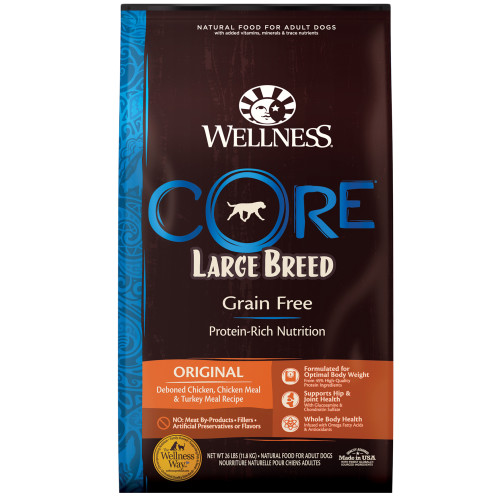May 5, 2017
Why Do Cats Seem More Finicky Than Dogs When it Comes to Food?
Pam Johnson-Bennett is a certified cat behavior consultant, best-selling author of 10 books and host of Animal Planet UK’s Psycho Kitty. With the release of her latest book, CatWise, she is currently on the national CatWise Cat Cafe Tour presented by Wellness.
Cartoons and social media memes often portray the finicky feline image. It’s common to see the picture of a cat turning his nose up at the vast array of food his loving cat parent has set out for him in a desperate attempt to please the picky kitty. You don’t see those images of dogs very much at all though. Fido comes running at record speed, leaping over furniture to get to his bowl of food, no matter what kind is being served. So, are some cats really finicky? If so, what contributes to the behavior? Here are some reasons why it may happen and what you can do to help prevent the behavior.
Cats are Creatures of Habit
Finicky eating may happen as a result of a sudden change in meals. Cats take comfort in familiarity and that applies to just about everything in their life – territory, the litter box, where they sleep, and yes, their food. When a cat goes to his food bowl he expects the meal to smell and taste the same as previous meals. Even the texture of the food is important. If you make a drastic change, especially going from one particular texture to an entirely different one, it can be enough of a curveball to cause a cat to reject the food. Changes should be done gradually by adding a little of the new food into the current one so your cat has time to adjust.
I’ve seen cat parents buy so many brands of food and then open a new kind every day in the hope that kitty will like the latest and greatest flavor. What usually happens though is that the cat gets stressed and confused by all the drastic and abrupt change.
Cats are Hunters and not Scavengers
A cat uses his nose to detect the temperature of food to determine whether it’s fresh. His nose is an important tool in pre-tasting a potential meal. For a cat who must rely on his hunting skills for food, this is an important safety feature to help ensure that he doesn’t accidentally ingest spoiled food. Your cat uses that same safety feature even though his meal is conveniently served to him. If food is left out too long, however, a cat will often reject it because it no longer smells or tastes fresh. This can be the case if you place wet food down for your cat to nibble on at his convenience. He may not come to the feeding station right away and by the time he does make his way there, the food may be too dry or hard. This mistake can even be made with dry food if a mound of it is left in the bowl for so long or if you just top it off without ever emptying uneaten food. If it has been sitting too long, it goes stale.
Don’t serve cold food straight from the refrigerator. The temperature is uncomfortable for the cat’s stomach and it also won’t release enticing aromas. Cold food is a common contributor to finicky eating, as is heating food in the microwave to an unsafe temperature.
Bribery, Begging and Bad Choices
Finicky eating may also develop if you’ve fed your cat from the dining table. Why should kitty eat his own food when he can get his fill of rich, spicy food off your plate? Feeding your cat from the table means he won’t have enough of an appetite for his own food. In addition to finicky eating, this type of behavior also means the cat won’t be getting the appropriate nutrients and may even be getting foods that are harmful to him.
Some cat parents try to entice their cats back to the food bowl by mixing in bits of tasty food from the table. What often happens is that the cat starts eating around his food instead.
Stressful Mealtime
In nature, a hunter makes sure he’s in a safe location before he begins to eat. That precaution is necessary for survival and even the most pampered indoor cat has that instinct as well. Mealtime should be a time of security, calm and safety. If the feeding station is located in a chaotic area of the house, the cat may not feel comfortable to sit and finish his meal or maybe he’ll develop the habit of just nibbling now and then when the coast appears to be clear.
Stress can also be related to the type of food bowl you use. A bowl that’s too narrow may cause discomfort to his sensitive whiskers if they get bent or squished. The cat may develop the habit of paw-dipping to get food.
If you have a multicat household, it’s very important to ensure the feeding station for each cat provides safety and peace. If there’s tension between the cats or if one cat intimidates at the food bowl, it can create a situation where a more timid cat may become a finicky eater.
Cats have a social structure but they’re not social eaters the way people are. We love to gather around the table and socialize as we dine, but for cats, the security of the resource is more important. To help encourage healthy appetites and stress-free dining, make sure each cat has their own food bowl and don’t place them close together. In some cases, you may even need to have multiple feeding stations in various locations in the home or feed on different levels. For example, if an older cat has started to reject his food because he prefers the taste of his new companion’s kitten formula food then you must make sure to either supervise during mealtime or feed the cats separately. If the older cat is not as mobile, you might be able to feed the kitten in an elevated location.
The key is to evaluate your specific set-up, pay attention to the dynamics between your cats and make adjustments to create a more peaceful mealtime.
Feeding Station Maintenance
Dirty food or water bowls can contribute to finicky eating. Remember, cats rely on their noses to determine if food is safe. Even fresh food won’t taste fresh if it’s placed in a dirty bowl or if it’s sitting next to the water bowl that has bits of old food floating in it. Wash the food bowl after every meal and clean up any food spills. Wash the water bowl every day and replenish it with fresh water.
Negative Associations
For some people, the thought of medicating the cat brings images of engaging in feline wrestling while trying to avoid becoming the target of a sharp claw or tooth. To make it easier, the cat parent may try to disguise the medication in the food. Sadly, this practice often backfires because the cat’s incredibly sensitive nose is often able to detect the food manipulation before the first bite. If the cat does start to eat, the medicine may ruin the taste of the food enough to cause future rejection. Some pills, for example, are very bitter and meant to be swallowed intact so the protective coating can remain until the medicine reaches the cat’s stomach. It’s very sad to see a cat no longer want to eat the food he has always loved because of this unpleasant association.
If you have to medicate your cat and are unable to do it, talk to your veterinarian about other options. Your veterinarian or veterinary technician can show you several techniques for administering medicine. There are also soft treats available that are manufactured specifically to hide pills. Some medications can be compounded into transdermal forms or can be flavored with tastes that are cat-appealing. Don’t resort to hiding medication in food.






